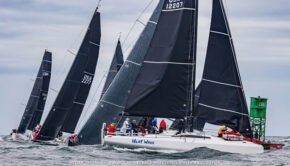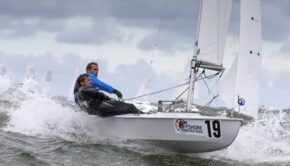Administering rules at the elite level
Published on August 19th, 2024
Most racing occurs between competitors without umpires on the course, leaving it to the sailors to police themselves within the Racing Rules of Sailing. It is not a perfect system, but when you consider how the sport has survived by using it, is it good enough?
The trouble is that the sport began with a strong Corinthian ethos, and much of that is now gone. Wherein once a competitor may drop out of race when knowingly committing an infraction, it is may not happen today if there were no witnesses.
The result is how major events such as the Olympics have umpires on the course which, depending on the event, can issue penalties. But with no video replay, their judgement is imperfect, and the subjective assessment of kinetics (rule 42) is a reoccurring hot button.
When Ted Keenan proposed a rethink of this rule, the feedback from the Scuttlebutt community came in. Here’s a sample:
Having taught rule 42 enforcement to other judges, and judged many regattas in the USA as well as Canada, I can count on one hand the number of times I have heard a rule 42 protest from one competitor against another.
Competitors will protest for part 2 rule violations but to protest a fellow competitor for a 42 violation, they are calling them out as a cheater. I have judged Laser (ILCA), Finn, Optis, C420, I470, I420, 49er, and 49FX. I have seen just about every rule 42 infringement competitors can come up with to give them an advantage.
Every fleet has different ways to try to gain that advantage. There are guidelines on the world sailing website directed to judges to look out for the most common breaches of rule 42. Competitors need to read these documents as well.
Having been the Chief Judge at CORK for many years, I would have the athletes in a large room and show them a powerpoint presentation of common infractions the judges would be looking for. I would take questions and have great discussions about the 42 rules. These sessions made the judge’s job easier during the regatta.
The take from this is that competitors will not protest each other for 42 violations. Judges will be needed on the playing field to even out the sailing. Judges need to be trained by a competent judge on 42 violations and stay up to date on changing ways the sailors come up with to give them an advantage.
– Mike Dawson, U S Sailing National Judge
——————-
I can empathize with frustration over rule 42 judging, but I don’t see how Ted Keenan’s proposal would successfully make things less arbitrary. As I read it, Mr. Keenan proposed that only sailors initiate a rule 42 protest. I assume he meant for an on-the-spot decision, since sailors can already protest another boat for rule 42. However, the challenge we have of not having enough judges who can be in enough places on the water at any moment in time would remain unchanged.
It’s also part-and-parcel of the Olympics that in any sport where there is judicial subjectivity, there will be outrage. Sometimes it feels very warranted from where we, the spectator, are sitting but usually the umpires are undeserving of the vitriol aimed at them. I have to believe that the judges chosen to be on the water for the ILCA 7 medal race knew their stuff and also knew dinghy sailing.
In sailing, we don’t have video assistant referee (VAR), where you need multiple camera angles to make a reasonable call. Thus, for our sport to work, we have to trust a small group of trained, but still human, people doing their best. I also believe that rule 42 is best judged on the scene, rather than in the jury room like a typical Part 2 incident.
– Giff Constable
——————-
My initial response to the idea is that it is a logical proposition. It is only fair that the competitor has the opportunity to decide the initiate actions for a breach of rule of the game. Sure enough we have this philosophy embedded in the Racing Rules of Sailing under the “Basic Principles”.
From my experience I have noticed that this principle is followed to the tooth and nail when a situation is one to one. The action is almost imminent when two or more boats are involved in an incident and there is a feeling of disadvantage or breach of rules. Seldom there is a protest for incidences happening where the competitor is not directly involved or disadvantaged.
The moot question here is are we comfortable to leave the breach of RRS 42 at the discretion of “someone” who may or may not be directly impacted. How many competitors would be looking out for another boat close by or far away breaking RRS 42 and make an effort to reach out to a jury to initiate action.
An important issue to understand is that the currency of the incident (time lapsed) and the sighting of the breach are important ingredients to arrive at a conclusion to penalize or not. A lot of practical and procedural processes would have to be worked out to meet this requirement. May be possible, I agree, and leave it to the authorities to look at feasibility.
By following this methodology, in my opinion, we may be unfair to the people who are competing fairly and expect us to make the competition as fair as possible.
– Capt. Tribhuwan Jaiswal
——————-
I have been involved in yachting sport, high level club management and class management for about 60 years. This group of compliance-oriented people have risen above their station in life and are controlling the sport to illogical extremes instead of supporting the key people, the sailors. The tail is now wagging the dog to the detriment of our great sport. Just let them get on with the sport and ENJOY IT!!!
– Chris Hardy
——————-
I suggest that all IJs who flag for pumping wear a head camera and record the scene live. Twice I received yellow flags by IJs who were not in a position to see what was going on.
One IJ actually disqualified me, for not doing a 720 after receiving a yellow flag. He claimed that while doing the 720, I did the first 360 going in one direction but then followed it by doing the second 360 going the other way. What the IJ saw were two different boats going in different directions. With the sun behind us blinding his eyes, he confused the two different boats thinking it was the same one.
The second yellow flag came from an IJ returning from another race course and saw the leech of my sail flicking. He came from a long ways to point the flag at me. What he couldn’t see from a distance is that I was frozen on my boat, and that the sail movement was caused by a wake from a ferry boat that was no longer there by the time he arrived. I was far left of the fleet and was the only one affected by the wake at that moment.
I respect IJs who are many times volunteers, but if they would have to show footage and explain why they gave the flag at the end of the racing day, they may flag with more caution. In all other sports I can think of, the judges have video footage made public, to help them improve.
– Ari Barshi








 We’ll keep your information safe.
We’ll keep your information safe.